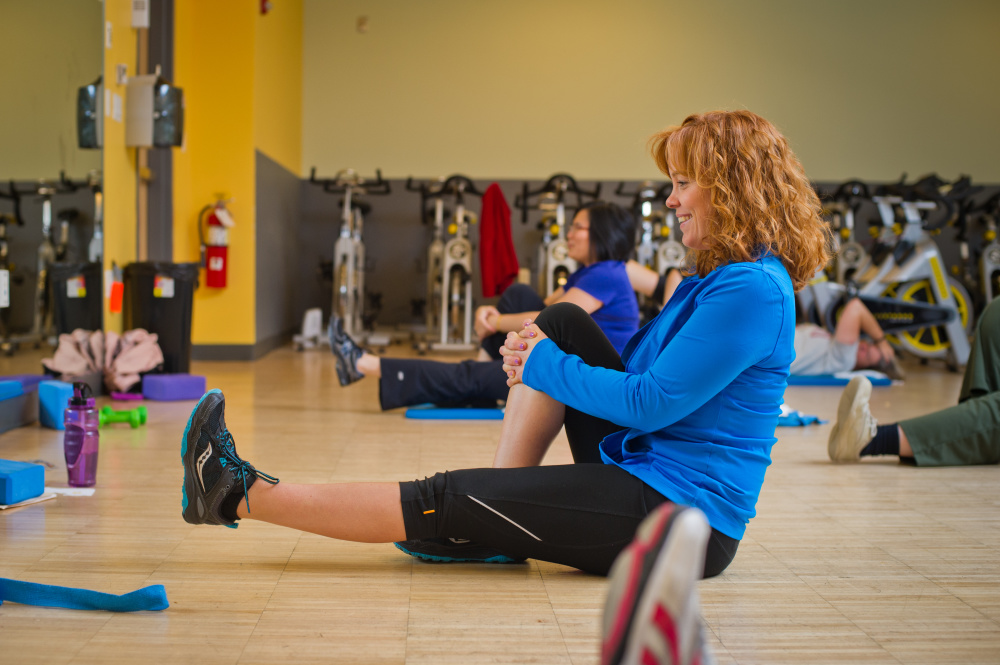Key Takeaway: Research shows that strength training, a type of exercise that can build muscle mass, can improve health in cancer patients.
Strength training is a type of exercise in which one uses resistance to force the muscles to contract to build strength. Resistance for strengthening can come from a person’s own body weight or from gym equipment.
We spoke to Nancy Campbell, MS, an exercise physiologist at Dana-Farber’s Leonard P. Zakim Center for Integrative Therapies, who offers exercise consults to cancer patients and survivors.
What are the benefits of strength training?
Campbell: Strength training can have many benefits for patients and non-patients, including:
- Increased muscle mass, which is often lost during treatment
- Maintain or increase bone density
- Increased metabolism
- Weight loss
- Weight gain from muscle mass
- Help countering diseases such as diabetes
- Lower blood pressure
- Help regulating insulin
- Normalized balance
- Improved posture
Are there trainers who specialize in strength training for cancer patients?

Campbell: Yes. The American College of Sports Medicine offers a cancer-specific certification for trainers, though the amount of certified trainers in the state is minimal at the moment. ACSM has recently revamped their guidelines on exercise and offers a list of resources for cancer patients.
Another great resource for training is Livestrong at the YMCA. Livestrong offers a training program for cancer patients and survivors, which takes place at YMCAs across the country. The trainers are knowledgeable on various cancers and exercises that will be most beneficial for different patients. Courses run twice a week for 12 weeks at no cost.
At Dana-Farber’s Zakim Center, patients and survivors can join exercise classes and programs, ask fitness-related questions, and get help with personalized exercise tips.
When is the best time to begin strength training?
Campbell: As soon as possible. It doesn’t take long to lose muscle mass, so starting training early on is best. It’s also a lot harder to regain muscle mass then it is to try not to lose it.
Research also shows a correlation between muscle mass and rates of survival.
How can I do strength training at home and what are some examples of strength training?
Campbell: There is always risk that comes with training, but if done correctly, injury can be avoided. Consulting with a physician is important in ensuring practicing safe exercise.
Strength training can be done with or without equipment. Wall sits, squats, and push-ups are good examples of strength training that can be practiced without equipment. These exercises can be modified slightly to fit the patient’s desired level of difficulty.
Using household objects such as soup cans, or purchasing equipment such as dumbbells, and exercising with these can help build strength, as well.
Is strength training or cardio better for your overall health?
Campbell: I’d say they are pretty equal. However, new findings are showing the significant benefits that come as a result from strength training.
It is important to recognize that various components of exercise are important: Getting heart rate up, practicing mindfulness, stretching, and building strength can all lead to improving one’s health.
About the Medical Reviewer
 Nancy Campbell is a Clinical Exercise Physiologist in the Zakim Center, is a Certified ACE Personal Trainer, and has the American College of Sports Medicine Cancer Exercise Trainer certification. She provides personalized exercise consultations for patients. Nancy also teaches several strength training-based exercise classes for patients and survivors.
Nancy Campbell is a Clinical Exercise Physiologist in the Zakim Center, is a Certified ACE Personal Trainer, and has the American College of Sports Medicine Cancer Exercise Trainer certification. She provides personalized exercise consultations for patients. Nancy also teaches several strength training-based exercise classes for patients and survivors.
For me, exercising with Nancy Campbell and the Zakim Center has been the greatest asset for my recovery. I have gained strength and stability. I have more confidence in my abilities. I feel better. I look better. I could not have accomplished so much without exercising.
Meeting Nancy and attending her exercise and strength training classes has changed my life. I have been a ‘regular’ two times a week since ending treatment 2 years ago. In this time I have gained strength, visible muscle mass, and have noticed streamlining of my body. Her classes are enjoyable. Nancy explains the hows and whys and what-fors of each exercise which helps me to keep proper form and to make sure I am engaging the targeted muscles. I would highly recommend any of her classes. I am grateful to have this Zakim program and to have Nancy and my classmates, in particular, in my life.
I’ve taken classes with Nancy many years ago and she is so encouraging. She and her assistants tailored exercises to meet individual abilities helping all participants to do the best they are able to do.
So great to have these resources at DFCI. Nancy is awesome to work with. This topic deserves more attention, as patients can be overwhelmed by treatment and side effects, so exercising is the last thing to take on. The insights that Nancy shares will convince anyone how important it is during and after treatment.
Fitness classes at the Zakim have been a blessing! The Fit and Strong class especially has have been helping with regaining strength and stamina post treatment. Nancy Campbell’s knowledge and kind attention to the needs and abilities of class participants is awesome!